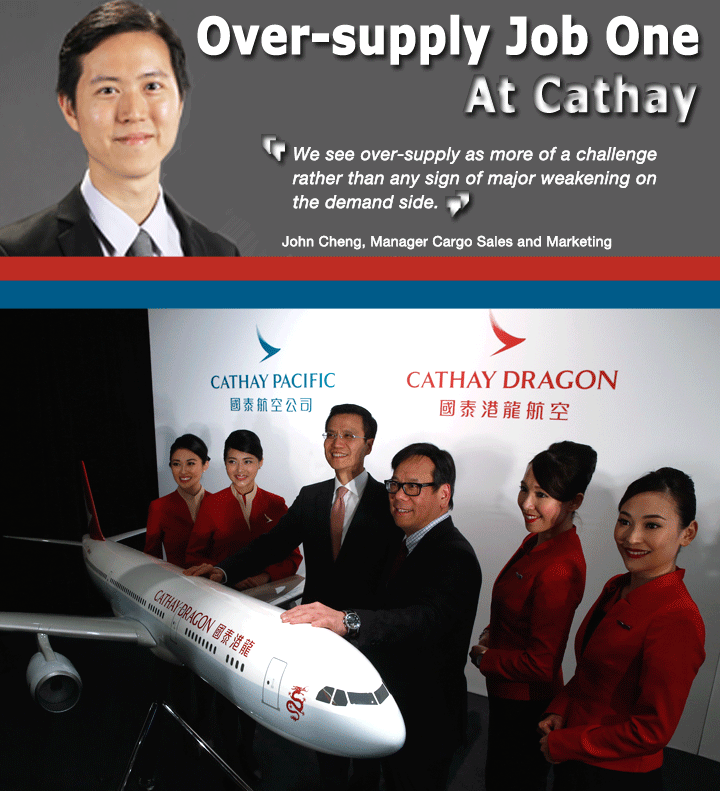
Last January, Chief
Executive of Cathay Pacific Ivan Chu (third left)
and Chief Executive Officer of Dragonair Algernon
Yau (third right) rebranded Dragonair as Cathay Dragon.
Mr. Chu said that this was not a merger, as “Cathay
Dragon remains a separate airline."
Cathay Dragon's livery features existing elements
of both carriers, but most noticeable is the adoption
of the Cathay Pacific brushwing logo.
On July 11 Mr. Yau went on indefinite leave “for
personal reasons” and Cathay’s Director
of Corporate Affairs James Tong now serves as acting
chief executive of Cathay Dragon.
In
the 12 months leading up through April 2016, Cathay
Pacific and sister carrier Dragonair saw both volumes
and revenue in tons per kilometer drop compared to
the previous year, by some 1.8 percent and 3.4 percent
respectively. This came despite a 2.1 percent year-on-year
tonnage uptick in April that the carrier said was
a “better than expected” performance underpinned
by the capture of shipments out of China and India.
But despite the slowing
of the Chinese economy and disappointing demand from
key European and U.S. markets, John Cheng, Manager
Cargo Sales and Marketing, told FlyingTypers his main
concern was the excess of capacity in global freight
markets.
“We see over-supply
as more of a challenge rather than any sign of major
weakening on the demand side,” he explained.
“As we entered into 2016, we were faced with
an increasingly competitive market environment, with
overcapacity continuing to put pressure on cargo yield.
We will continue to review our freighter capacity
to make it commensurate with demand.”
And that freighter capacity
is substantial—Cathay has some 24 freighters
in operation at present and one more 747-8F is due
for delivery later this year.
Cheng said Cathay was
the leading air cargo carrier in Asia last year, having
carried a total of 1.8 million tons of cargo and mail.
“This was against a capacity increase of 5.4
percent and a 5.4 percent rise in revenue-tons-kilometers,”
he said. “The company currently operates freighter
services to 46 destinations and also carries freight
in the bellies of its 140-plus passenger aircraft,
which serve a growing global network.
“The company is
going through a brand refresh with new livery to symbolize
continuous efforts to deliver excellent service to
our customers. The new livery will be progressively
introduced onto all the aircraft in both its passenger
and freighter fleets.”
As
we went to press . . . Cathay Cargo adds B747-8
twice weekly freighter service into Portland International
Airport (PDX), launching on November 3, 2016.
It will operate on a Hong Kong–Anchorage–Los
Angeles–Portland–Anchorage–Hong
Kong route every Thursday and Saturday.
Cathay and Dragonair said they carried
151.130 tons of cargo and mail in June for an
uptick of 7.1 percent over June 2015.
CX said, “cargo tonnage has
stabilized but yields continue to suffer.” |
However, although Cathay has ramped up its marketing
efforts, recent reports suggest the company is making
major cutbacks to contain costs, with Chief Executive
Officer Kwok Leung (Ivan) Chu admitting that business
challenges had become more acute in recent weeks,
with continued pressure on its cargo business being
compounded by “a weakening trend in the passenger
business.”
Cheng said that Cathay
was responding to the challenges facing its cargo
business by further developing its range of service
options for customers, including exploring how to
improve existing specialist products such as Wine
LIFT, Pharma LIFT, Priority LIFT, DG LIFT, Fresh LIFT,
Live Animal LIFT, Secure LIFT, Courier LIFT, and Expert
LIFT.
In May the company also
announced plans to create a freight network with Lufthansa
Cargo starting next year. Initially this will focus
on Hong Kong to Europe services before expanding to
eastbound services as 2017 progresses. Customers will
be able to access the combined networks of the two
carriers via either airline’s booking system,
while joint handling at HKIA and Frankfurt will mean
shippers have a single point for export drops and
import deliveries.
“We continue to
invest in our products and services to provide superior
service to our customers,” said Cheng. “An
example is our Pharma LIFT product, which provides
excellent cold chain logistics for high value, temperature
sensitive service for the life sciences market.”
The carrier also has
a sizeable presence in South East Asia and India,
markets it has previously referred to as “lower
yielding.”
Cheng said key products
from SE Asia and India were perishables, garments,
and IT products. “Overcapacity
in these markets has led to comparatively lower cargo
yield,” he admitted. “Our focus is on
pharmaceutical traffic, which sustains higher yields
for service quality.”
SkyKing





